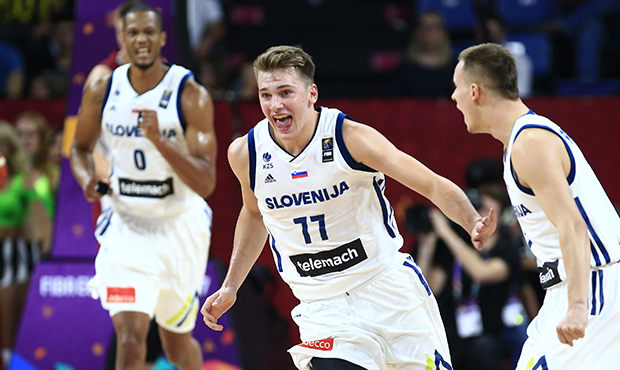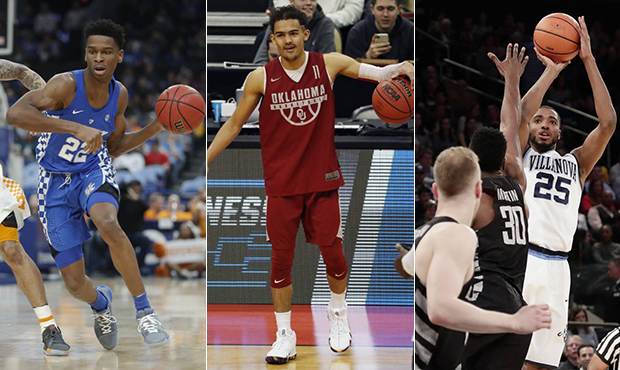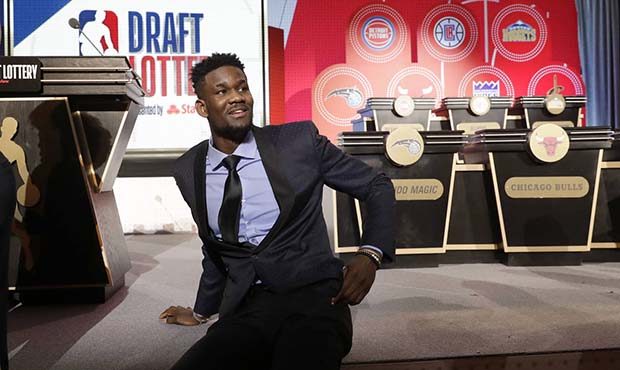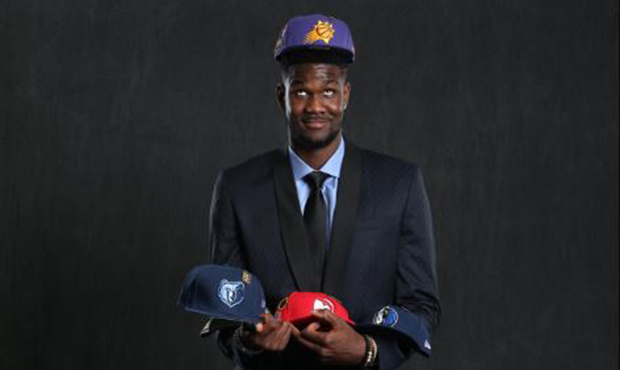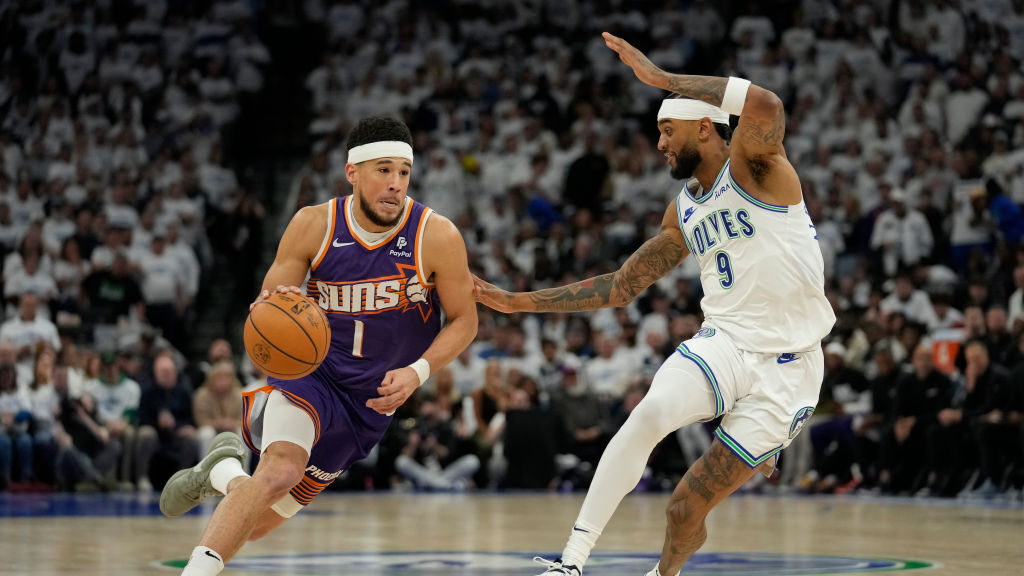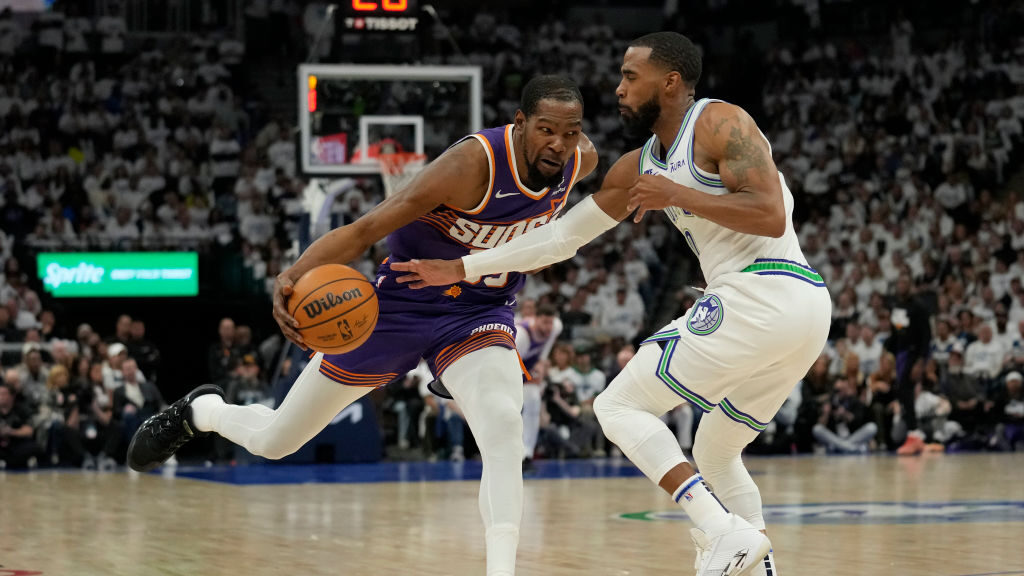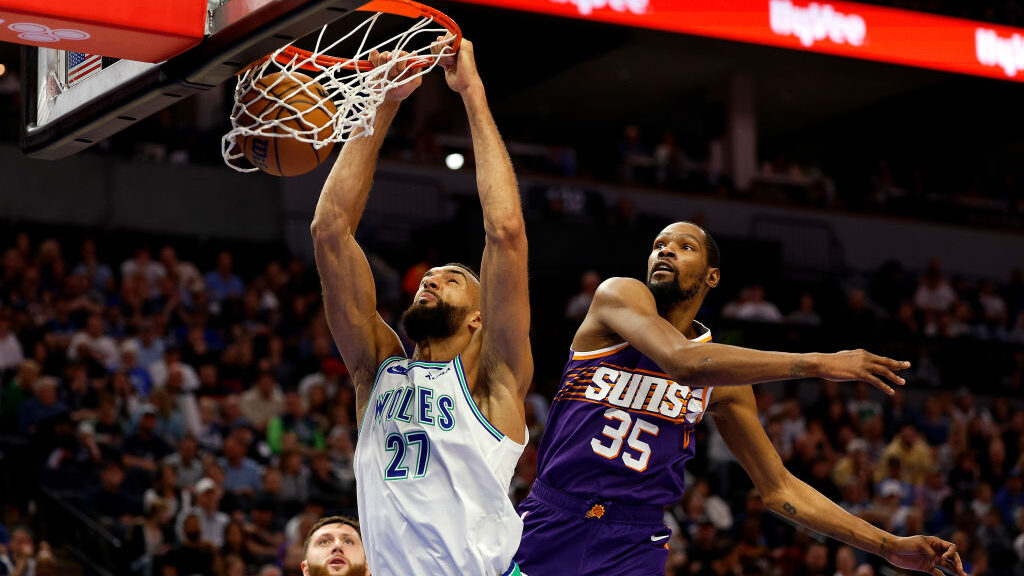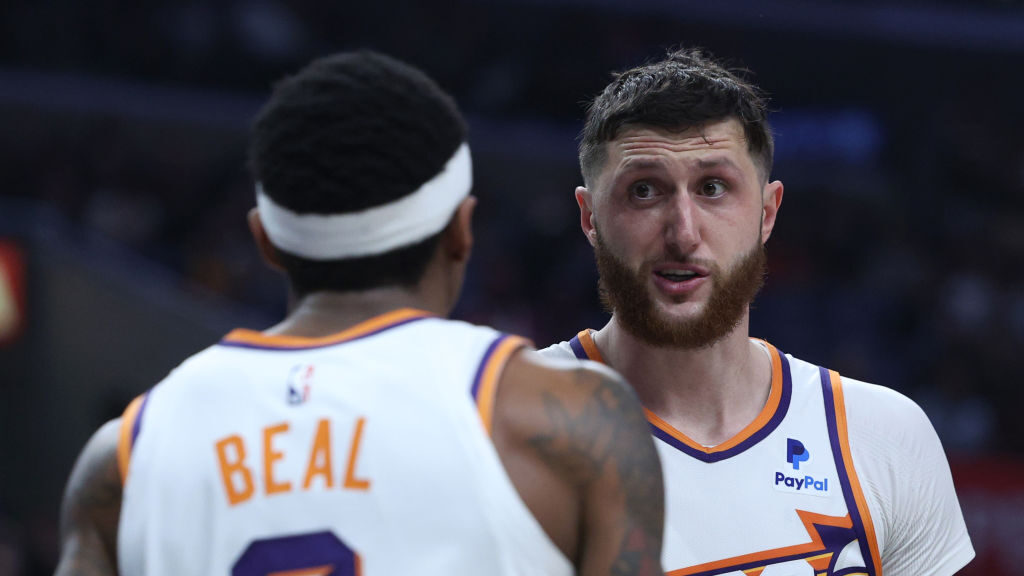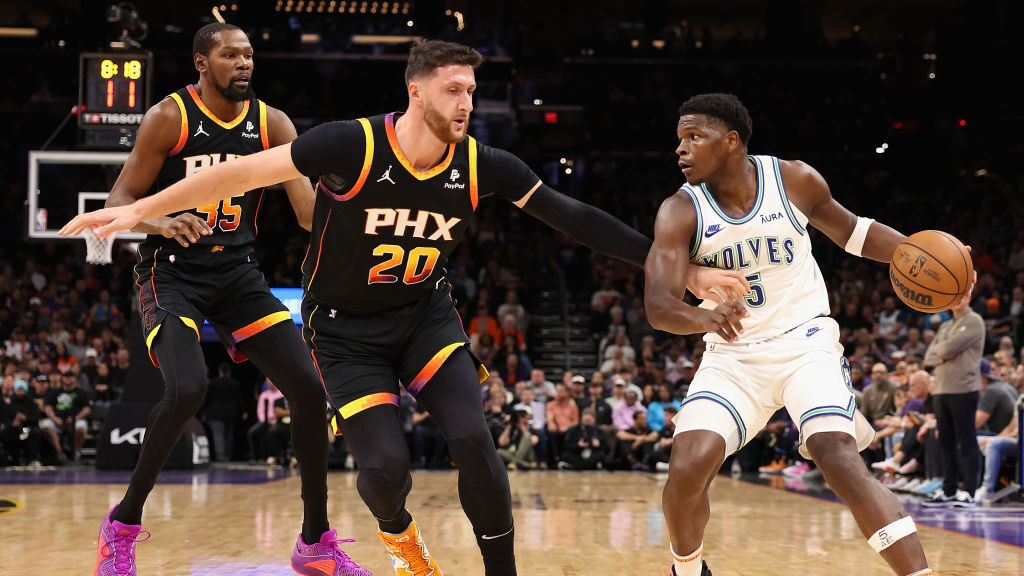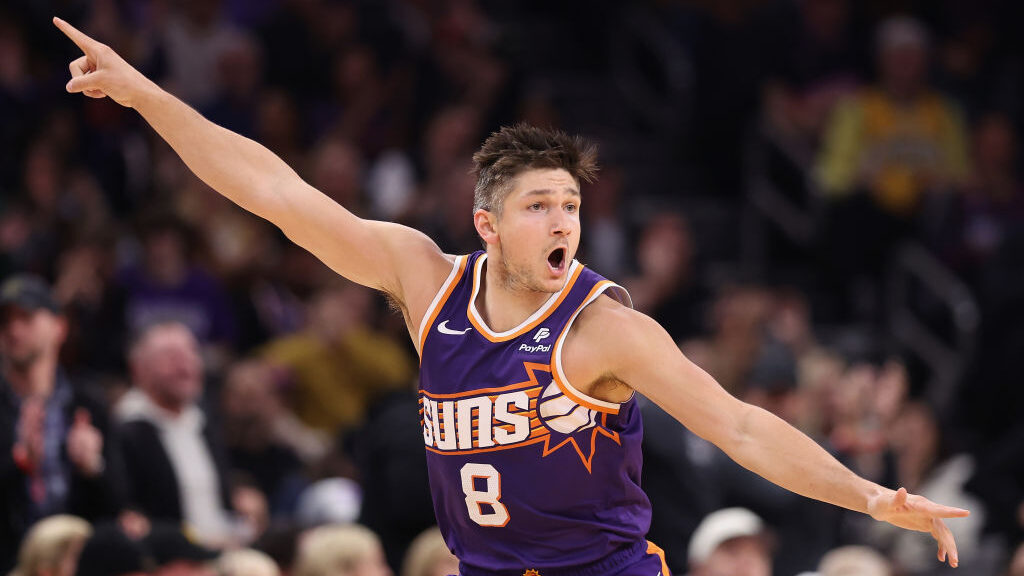Why Deandre Ayton is the favorite to go No. 1 in the NBA Draft
May 18, 2018, 6:01 AM | Updated: Jun 1, 2018, 8:39 am
Understanding the draw of Deandre Ayton as the top prospect in the 2018 NBA Draft isn’t difficult.
Just look at him.
But from there, we enter into a unique evaluation of the Arizona Wildcats product, who is the heavy favorite to be selected with the Phoenix Suns’ No. 1 overall pick.
Critics and fans can agree that Arizona didn’t employ the best roster nor run the best systems for Ayton to operate within.
The results of that — good and bad — will be a thing to touch on as we go along in this overview.
Playing as a power forward alongside lumbering offensive-minded center Dusan Ristic, Ayton still produced 20.1 points, 11.6 rebounds, 1.6 assists and 1.9 blocks in 33.5 minutes per game. His role put him on the perimeter more than most centers. He found himself guarding college power forwards, which often meant players with the skills of NBA wings.
Around Ayton were NBA prospects Rawle Alkins, a do-it-all small forward who battled injuries this year, and Allonzo Trier, a score-first and score-second shooting guard who along with Ayton was one of the most efficient players in the nation.
The Wildcats were arguably the most dysfunctional defensive team since head coach Sean Miller arrived, lacking consistency and communication while running a man-to-man scheme that leans on-ball pressure and help defense. That makes it hard to judge one player.
Offensively, Arizona ran Miller’s motion offense, which lacked heavy use of pick-and-rolls. Inconsistency from perimeter players added to the struggles, and teams soon figured out how to stop Ayton.
It’s safe to say no team got zoned more than Arizona last season, and as a result, the big man struggled to find premium offensive touches.
Across the board, Miller didn’t change the overarching schemes of his offense or defense to fit the personnel or the opposing defense. That played into all of the questions hovering over Ayton, who nonetheless produced a dominant season.
He dominated with a set of attributes that are some of the best the draft process has seen in a big man in years.
Elite athletic skills
Even without Ayton participating at the NBA Draft Combine this week, it’s fair to assume he could take the time heading into his rookie season to improve upon his 7-foot-1, 250-pound frame. The Bahamian big hadn’t lifted until joining the Wildcats last year, indicating an offseason’s worth of work could make him an even more imposing figure.
Imposing Ayton was as a college player, and his physical traits played a huge part in his production.
While his strength and length will be negated playing in the NBA, Ayton’s potential is based upon how he uses his size and 7-foot-5 wingspan combined with his unique agility. Ayton sprints instead of lumbers running the full court. The speed he lifts off the ground on first, second and third jumps is extraordinary.
In the post, he used his great footwork to operate in small spaces, squeezing through two bodies, or spinning off or through a single opponent.
This series of moves displayed against UNLV brought a groan out of one TV analyst.
Ayton has expressed a distaste for jump hooks, yet he uses them to some degree.
This play against USC center Chimezie Metu, a likely draft pick this year, showed the combination of dribbles, spin moves and enough touch to score through contact.
The rapid series and quickness of getting into his moves help Ayton score before any double can arrive.
Ayton’s size, mobility, motor and leaping ability all came together to explain why he found college success from a scoring and rebounding perspective. And that’s considering he sometimes failed at boxing out and got the rebound anyway.
Nearly half of his shots were at the rim thanks to his brute strength, and he scored on an astonishing 82 percent of those close opportunities.
It’s as good of an athletic base as any top prospect in the past decade.
Success facing double-teams
As one can imagine, Ayton drew double teams quite a bit at Arizona. He rarely panicked.
This is where his footwork shined. Often, he was able to rip or slip through double-teams that came after he caught deep post-entry passes.
See below as he squeaked along the baseline — but notice it came after he pump-faked a pass to force ASU’s switching help defense to scramble back toward Arizona’s shooters. Ayton’s patience paid off.
Against man defenses, Ayton shined making the right decisions and flashing high-level court awareness when it came to teammates and defenders alike.
Alkins and Ayton both bringing the 💪🏾 pic.twitter.com/AhGHGdqN9e
— Barstool Arizona (@UofABarstool) March 11, 2018
Sometimes, Ayton’s passes weren’t as flashy.
He reacted to double-teams simply by taking a dribble or two out of trouble to keep the ball moving with a safe strong-side pass.
Other times, it meant finding a shooter on the weak side.
Facing up
Even more often, Ayton operated as a face-up player in Arizona’s offense.
When Arizona did run pick-and-rolls — and on the rare occasion he received a pass out of it — he usually opted to pop out for jumpers rather than roll to the rim. Against zones, he faced up around the short corner or elbow to shoot midrange jumpers.
According to Hoop-Math, 44 percent of Ayton’s shots were two-point jumpers, and he hit a respectable 43 percent of them (62 percent were assisted buckets).
A promising tidbit to his potential as a shooter was his 77 percent free throw shooting in Pac-12 play — much improved from his nonconference numbers that brought his season average down to 73 percent.
With a low release relative to his height and a low trajectory, questions remain about whether Ayton can extend his range to the NBA-three-point line. He took just 35 three-pointers over the course of his freshman season, hitting 34 percent.
What is his ceiling and floor on defense?
For all of his offensive awareness, Ayton’s lack of it on defense is confounding.
According to ESPN, the 28-player list of top-10 picks who averaged 0.7 steals and 2.3 blocks or less per 40 minutes (the year before they were drafted or one year prior) is riddled with, mostly, plodding big men.
Even more oddly, Ayton displayed more competence on the perimeter than he did defending the interior.
Yes, he did average 1.9 blocks per game, and his natural athleticism and size should be quite the imposing rim presence at the next level. Yet, there were too many instances where Ayton not only didn’t go for a block but didn’t even move into the vicinity of a lane to cut off a drive as a weakside helper.
Below he opted to shift away from a posting big man toward the corner where one Oregon State player was already defended by a teammate.
What is this? pic.twitter.com/hmGEG3V0eT
— Kevin Zimmerman (@KZimmermanAZ) February 23, 2018
Ayton recorded 66 blocks in 1,172 minutes at Arizona. He swatted 6.1 percent of the available shots to block, per Sports-Reference, or less than half the rate as top-five prospects in Michigan State’s Jaren Jackson Jr. (14.3) and Texas’ Mohamed Bamba (13.1).
Again, Ayton’s pseudo-power forward role played a part in this, especially when teams attempted to mismatch him against smaller defenders, pulling him out of the paint.
But the questions linger. For a traditional-looking center in a new age of perimeter-oriented basketball, where does Ayton stand?
Well, it’s hit and miss.
Ayton’s stride and light feet looked good when he was on the perimeter, in position and isolated against even point guards. In the NBA, that’s good news for having to switch late in games.
But the problem is Ayton struggled the most when the game was moving fast around him. Switching itself proved problematic at Arizona, though it would be unfair to put the blame all on the big man.
The fourth-seeded Wildcats’ 89-68 loss to Buffalo in the opening round of the NCAA tournament revealed all of Ayton’s defensive weaknesses. Against a 6-foot-7 wing Jeremy Harris, Ayton didn’t navigate past off-ball screens, didn’t communicate, didn’t recover in pick-and-rolls, and then couldn’t contest the lanky guard off the dribble. Harris repeated came off screens to catch the ball with Ayton already out of position and unable to recover before he was blown by.
Again, some of those breakdowns were communication problems — maybe his teammates were at fault.
The challenge for whichever team selects Ayton will come in getting the reactionary tendencies, communication and motor the 20-year-old showed on the offensive end to translate to the defensive end.
To make Suns fans feel better: It doesn’t take much effort to make a comparison.
While Ben Simmons doesn’t play the position that has a job description of team defensive anchor, the LSU product had similar concerns about his defensive effort and awareness two years ago.
Now, Simmons is a favorite Rookie of the Year candidate.
On the break
While no prospect’s career should be judged on how he does in transition, it’s an important point to show that all the pieces come together for Ayton here.
He ranked eighth in college basketball by grabbing 21.4 percent of available rebounds last year because of his athleticism, but it’s what he did after that flashed all his tools. Ayton was a fantastic and alert outlet passer, who showed urgency grabbing a board and getting it to a guard ASAP so he could sprint up the court.
If the Wildcats couldn’t get a lob to Ayton or find an open shooter, the center gave much effort establishing early post position anyway. Even a defense scurrying back successfully to stop Ayton got caught over-helping on him as North Carolina State did here. Ayton made them pay.
What’s it all mean?
When mentally stimulated against Oregon, as Ducks fans teased him about his involvement in the recruiting scandal that linked him to coach Sean Miller and a sum of $100,000, Ayton displayed everything that has made him the favorite to go No. 1 overall.
Worrying about why he didn’t play with such anger and aggression all the time is the big wonder.
Ayton, who grew up a soccer player before getting into hoops, admitted that he simply didn’t need to learn the nuances of the game as a high school prospect. He’s been through the ringer with the scandal at Arizona and played at his best as it hit. As the season went on, he improved steadily, putting in better overall efforts and bigger numbers as the year went on — before the clunker of a finale.
Can he string a good rotation on a weakside shooter into a recovery in the paint when he deters the initial look? Is there an explanation for his bewildering decisions not to attempt to protect the rim? Did those decisions against blocking shots have anything to do with his own selfishness to stay out of foul trouble, or was it a result of a directive by Arizona’s staff?
Does any of that matter after he produced one of the most efficient offensive college seasons for a big man in recent memory?
For a Suns team needing talent and without a center of the future, it’s easy to see the local product heading to Phoenix.
If general manager Ryan McDonough believes Ayton is committed to fixing his flaws, it would be hard to pass on such a naturally talented and athletically gifted player.


